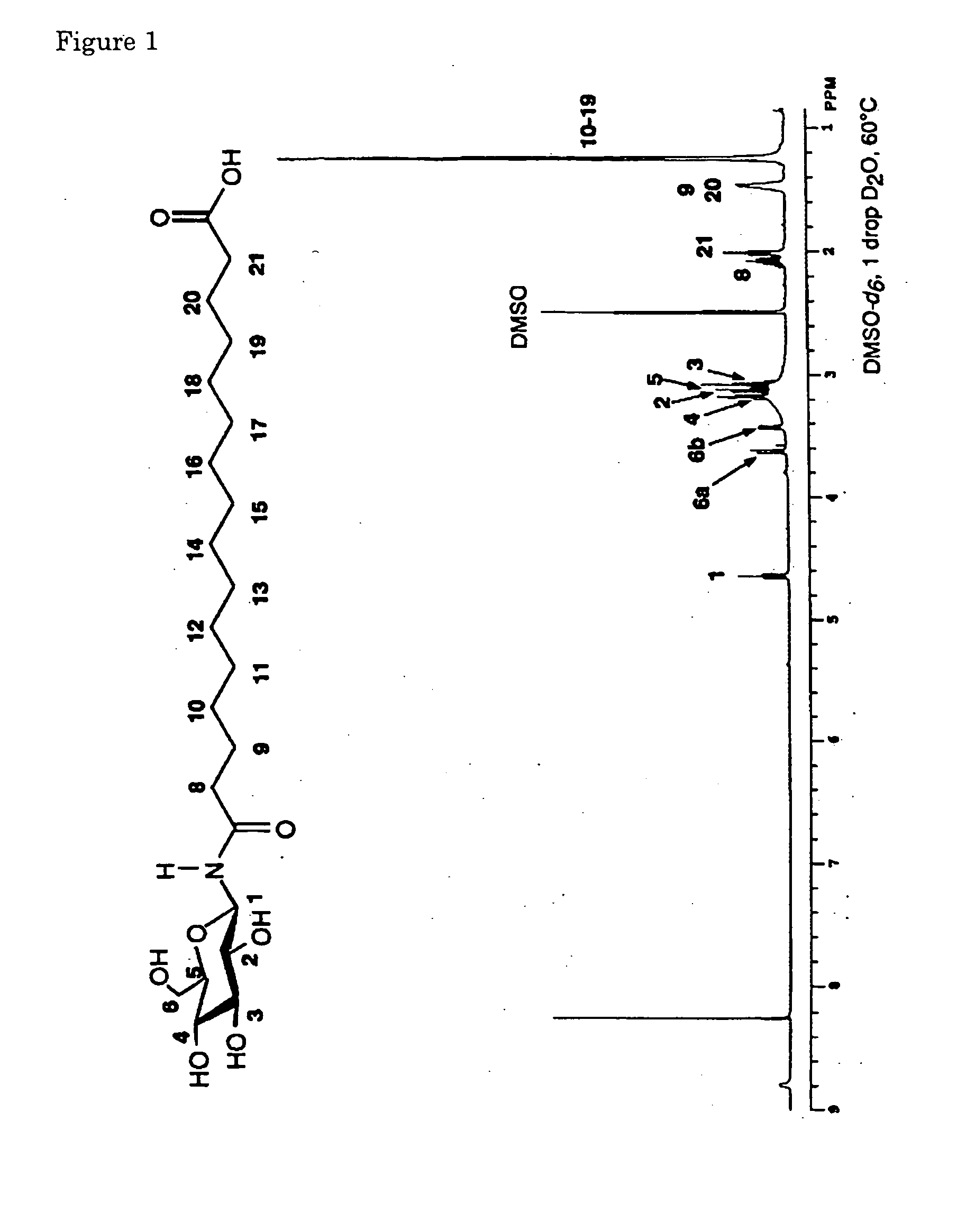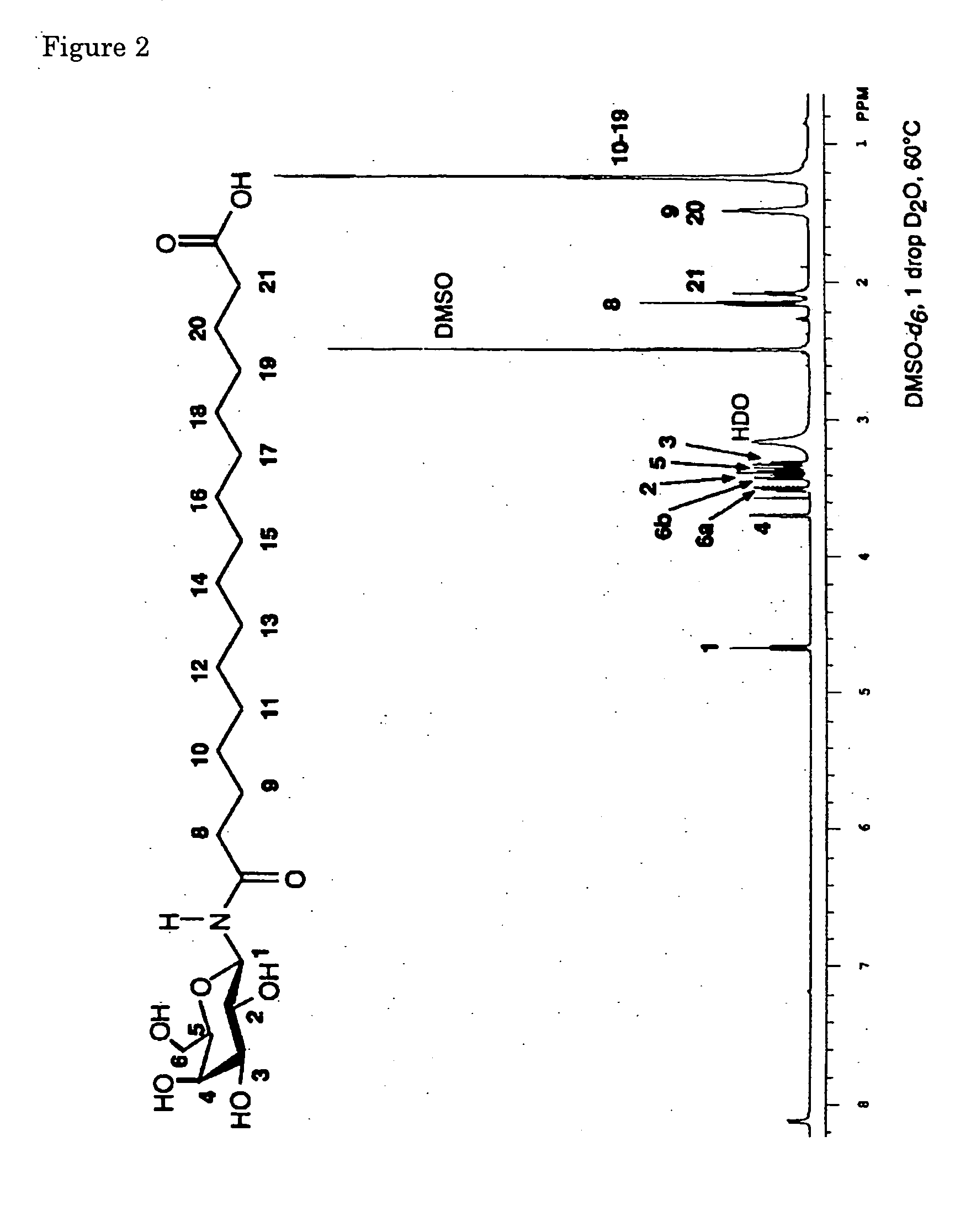Novel asymmetrical bicipital lipid and tubular aggregate formed by using the same
- Summary
- Abstract
- Description
- Claims
- Application Information
AI Technical Summary
Benefits of technology
Problems solved by technology
Method used
Image
Examples
examples
[0036] The present invention is next explained in further detail using examples, but the present invention is not limited by these examples. The Rf values in thin layer chromatography are reported as Rf.sub.1 when a mixed solvent of chloroform / methanol (volumetric ratio 20 / 1) was used as the development solvent, as Rf.sub.2 when a mixed solvent of chloroform / methanol / acetic acid (volumetric ratio 100 / 3 / 1) was used as the development solvent and as Rf.sub.3 when a mixed solvent of chloroform / methanol / water (volumetric ratio 64 / 31 / 5) was used as the development solvent.
production example
[0037] Five grams (12.2 millimoles) of 2,3,4,6-tetra-O-acetyl-.alpha.-D-gl-ucopyranosyl bromide was dissolved in 120 ml of DMF, and 15.8 g (243 millimoles) of sodium azide was added with agitation. The reaction mixture was agitated at room temperature for a day and a night while shielded from light. The reaction mixture was added dropwise to 1,000 ml of ice water with agitation, and the insoluble material was extracted using 900 ml of methylene chloride. The organic phase was washed with ice water and dried using anhydrous sodium sulfate. The drying agent was separated by filtration, and the solvent was completely removed by distillation under reduced pressure. The pale yellow solid obtained was washed using diethyl ether, dried and recrystallized from 2-propanol to obtain 3.30 g (79% yield) of 2,3,4,6-tetra-O-acetyl-.beta.-glucopyranosyl azide in the form of white needle shaped crystals. The physical properties of the product are shown below.
1 Thin layer chromatography Rf value: Rf...
production example 2
[0038] The same procedure described in Production Example 1 was used with 2,3,4,6-tetra-O-acetyl-.alpha.-D-galactopyranosyl bromide used in place of the 2,3,4,6-tetra-O-acetyl-.alpha.-D-glucopyranosyl bromide used in Production Example 1 to obtain 3.30 g (79% yield) of 2,3,4,6-tetra-O-acetyl-.beta.-galactopyranosyl azide. The physical properties of the product are shown below.
2 Thin layer chromatography Rf value: Rf.sub.1 = 0.7 Melting point: 96.degree. C.-97.degree. C. Elemental analysis (as C.sub.14H.sub.19O.sub.9N.sub.3) C H N Calculated values 45.04 5.13 11.26 (%) Measured values 45.18 5.00 11.56 (%)
PUM
| Property | Measurement | Unit |
|---|---|---|
| Temperature | aaaaa | aaaaa |
| Length | aaaaa | aaaaa |
| Diameter | aaaaa | aaaaa |
Abstract
Description
Claims
Application Information
 Login to View More
Login to View More - R&D
- Intellectual Property
- Life Sciences
- Materials
- Tech Scout
- Unparalleled Data Quality
- Higher Quality Content
- 60% Fewer Hallucinations
Browse by: Latest US Patents, China's latest patents, Technical Efficacy Thesaurus, Application Domain, Technology Topic, Popular Technical Reports.
© 2025 PatSnap. All rights reserved.Legal|Privacy policy|Modern Slavery Act Transparency Statement|Sitemap|About US| Contact US: help@patsnap.com



